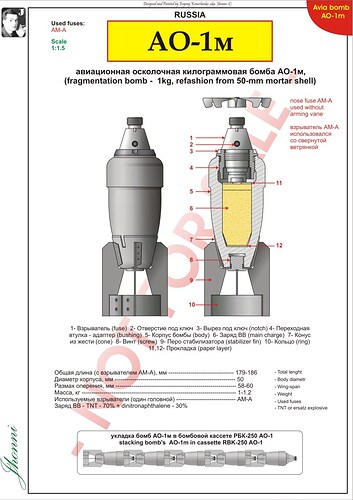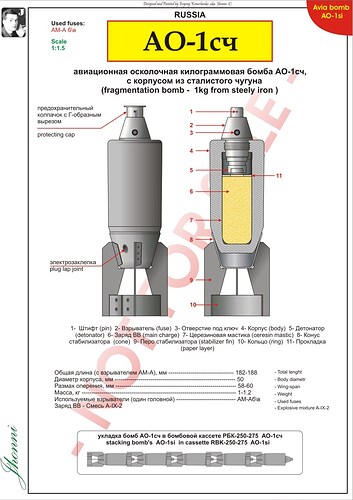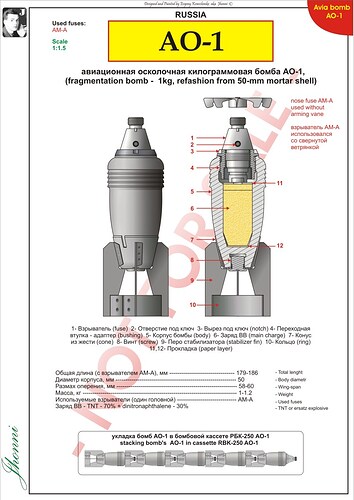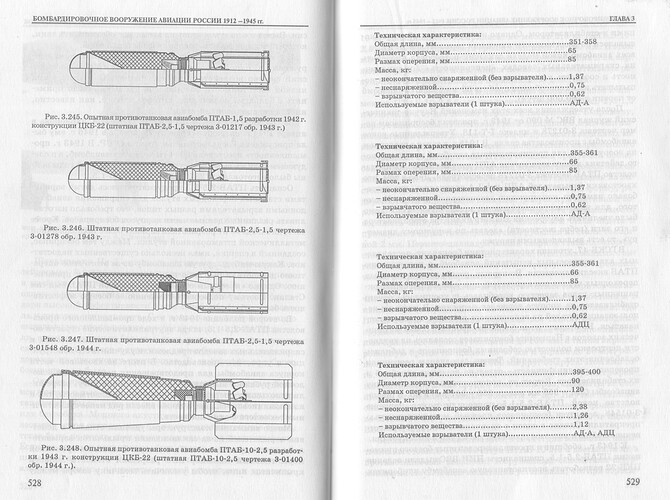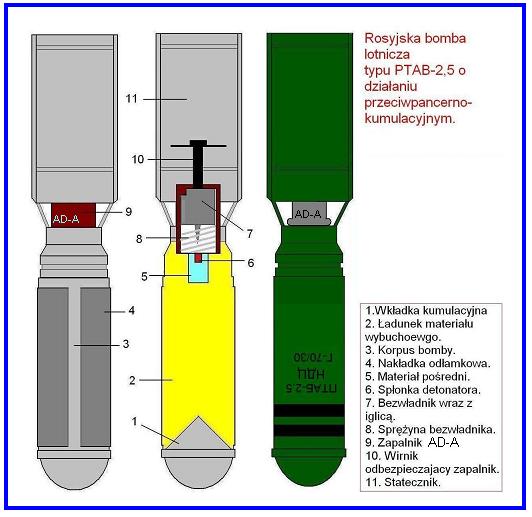Hello,
I look for Russian photographs of rockets RS82 because i haven’t any color of them. Could you help me, please
yok
I think there is a site that had color images of that, let me see if I can found it.

Hello,
this is in fact a modelers site - but the guys are well informed.
Check the site for more bombs, colors ect.
http://vvs.hobbyvista.com/Markings/bombs/vvsord.php
http://vvs.hobbyvista.com/Research/Ordnance/Betab/index.php
Best
Nice, thanks for the link and welcome.
Shkas 7,62mm MG.

The ShKAS (Shpitalny-Komaritski Aviatsionny Skorostrelnij, Shpitalny-Komaritski rapid fire machine gun for aircraft;) is a 7.62 mm machine gun widely used by Soviet aircraft in the 1930s and during World War II. It was designed by Boris Shpitalniy and Irinarkh Komaritsky and entered production in 1934. ShKAS was used in the majority of Soviet fighters and bombers and served as the basis for the ShVAK cannon.
ShKAS is a gas-operated machine gun. The high rate of fire is achieved thanks to the revolving 10-chamber drum fed by metal disintegrating link ammunition belt and the recoiling portion of the gun weighing only 921 grams.
The weapon first appeared as protitype in 1933 know as KM-33.

Initial production consisted of cable-charged wing-mounted and turret-mounted ShKAS with a synchronized version entering service in 1936.

A one-second burst from four ShKAS in Polikarpov I-153 or Polikarpov I-16 placed 120 bullets within 15 angular mils at 400 meters (1,312 feet) giving a firing density of 5 bullets per square meter of the sky. This was significantly higher than contemporary aircraft from other nations, especially considering that four guns with 650 rounds of ammunition per gun weighed a total of only 160 kg (350 lb).
Two remote controlled ShKas at the rear of Il-2.

Characteristics of the Shkas:

Type of action: gas operated, sliding breech (berthier type)
Overall lenght: 810 mm
Barrel lenght: 585 mm
Loaded weight: 11,35 kg.
Grooves: 4, one turn in 254 m, right twist
Charging: By hand
Rate of fire: variable, 1500 to 2000 rpm.
2 Shkas in Mig-3 Nose, the rate of fire of the sinchronizated variant was about 1250rpm. Note the heating jacket to avoid freezing at high altitude.

Nose gun in Archangelskij Ar-2 bomber.

Ultra ShKas.
As if the Shkas high rate of fire wasnt enough the russian technicians sought the way to increase it even more, probably for use in defensive emplacements.
The outcoming gun was the Ultra Shkas, the rate of fire was considerabely increased due a enlargement is the gas hole dameter.
That gave a tremendous 2700 rpm rate.
In order to withstand the large amout oh heat a heavier thicker barrel was used with a cooling jacket.

However the high rate gave some troubles in feeding and reliability, that caused the Shkas wasnt manufactured and used in large numbers.
The weight of this gun excedees 16 kg.
Berezin UB. 12,7mm.

In 1937 M. Y. Berezin began to project powerful 12,7 mm synchronous aircraft machine gun with the cartridge from 12,7-mm of infantry machine gun Degtyarev Shpagin DSHK 38.
During October - December of 1938 synchronous machine gun successfully underwent plant and range tests. On 12 April, 1939, there was soem troop tests 12,7 mm machine gun BS (Berezin synchronous) by the decision of the committee of defense was neglected into the series production. 12,7 mm the machine gun Of berezina on the ring mount VUB-E on the attack aircraft IL-2.
Installation of the machine gun Of berezina on the destroyer Yak-9 The automation of machine gun worked due to the energy of the gases, deviated form a hole in the bore. The bolt performed a wedge locking system. The characteristic property of its device was the supply of ammunition belt not with the recoil of moving elements as in the overwhelming majority of machine guns, but with their counterrecoil, i.e. of the return spring of machine gun.
For guaranteeing the required reliability of belt feed return spring was made multiple-wire. The merits of the Berezin machine gun included:
- The successful layout of entire automatism and separate mechanisms;
- High rate of fire
- Simple loading
- A comparatively small number of components and simple mechanism.
In spite of all its positive qualities, machine gun BS possessed some serious deficiencies. The difficulty of its recharging in air with the aid of the cable system, which required of the pilot of large physical efforts into the most decisive minutes of battle especially was shown; the defects, connected with the insufficient vitality of the separate parts of automation, appeared; they required the elimination of the reason for the appearance of some delays.
Working at further improvement of his system for purposes of the solution of these deficiencies and creation of general-purpose machine gun for its application at the basic weapon emplacements of all machine guns, M. ye. berezin developed general-purpose machine gun UB (universal Berezina) in three versions depending on site of installation - turret, wing and synchronous.
UBT
UBK
UBS

Basic details and mechanisms of all three versions of machine gun were preserved, with exception of the trigger and percussion devices, into which were introduced some changes, connected with the specific character of their application.
In the synchronous (UBS) and wing (UBK) versions was realized remote control of the system of recharge in the case of the appearance of delays in the shooting in air with the use of the compressed air.
This was the first in the Soviet aviation system of the pneumatic recharging of machine gun, which considerably facilitated its operation in field conditions. In connection with the impossibility to use pneumatic recharge on the turret machine gun (UBT) because of the overall sizes of cab, designer G. I. Nikitin developed for it retracting handle lever type. In the course of tests the machine gun UB smoothly worked at the 9000 in altitude height and, it continued to shoot in the steep turns, the chandelles, the loops, the barrels and the dive.
Weight of the machine gun UB in the synchronous version 21,45 kg, wing 21,14 kg, turret 21,43 kg.
Rate of fire in the synchronous version 700 - 800 vystr./min, wing and turret 900-1050 vystr./min. Fire unit and ballistics are identical to 12,7- mm by machine gun SHVAK. From 7 January through 22 February 1941, the machine gun Berezin successfully underwent troop tests.
UBT, Ilyushin il-2

On 22 April, 1941, the general-purpose machine gun Of berezina was accepted to the armament VVS. 12,7- mm machine gun UB ripened in time, since the war begun in two months revealed the ineffectiveness of 7.62-mm aircraft machine guns with the aerial gunnery. The production of machine guns UB was conducted on Tula weapons and Izhevsk the Machine Building Plants. In 1941 were released 6300 machine guns UB, in 1943 43690, in 1944 38340, 42952 in the year 1945.
The synchronous machine gun of berezina was used on the fighters I -15, I -153BS, Yak-1b, Yak-3, Yak-7b, Yak-9, MiG-3 and LaGG-3. The turret machine gun was established on the bombers SB, P -2, Yer-2, Il-2, Tu-2, Il-4 and Pe -8.
UBS in Yak-9 .

I am looking info and some pictures of this aviation bomb, if somebody have…please
PTAB is a generic name - was there a particular one that you want? The WW2 one?
Here are some examples:
https://naveodtechdiv.jeodnet.mil/AfghanOIG/PDF-low/02-Dispenser.pdf
[
](http://npaid.websys.no/item3/1171733987/Photo%20023.jpg)http://npaid.websys.no/item3/1171733987/Photo%20023.jpg
Thanks.
And yes is the ww2 device in wich I am interested, the one used by the Il-2 assaulter.
Thanks Lothar, I knew you going to have some 
By the nice cooperation with Jhonni, Moskau, Russia :mrgreen:
Nice, the “1” is definately the shaped charge warhead. 
Thanks again Lothar.
In the post #6 the bombs 1 and 4 are prototypes. The 2 and 3 are the ones used in battles.

